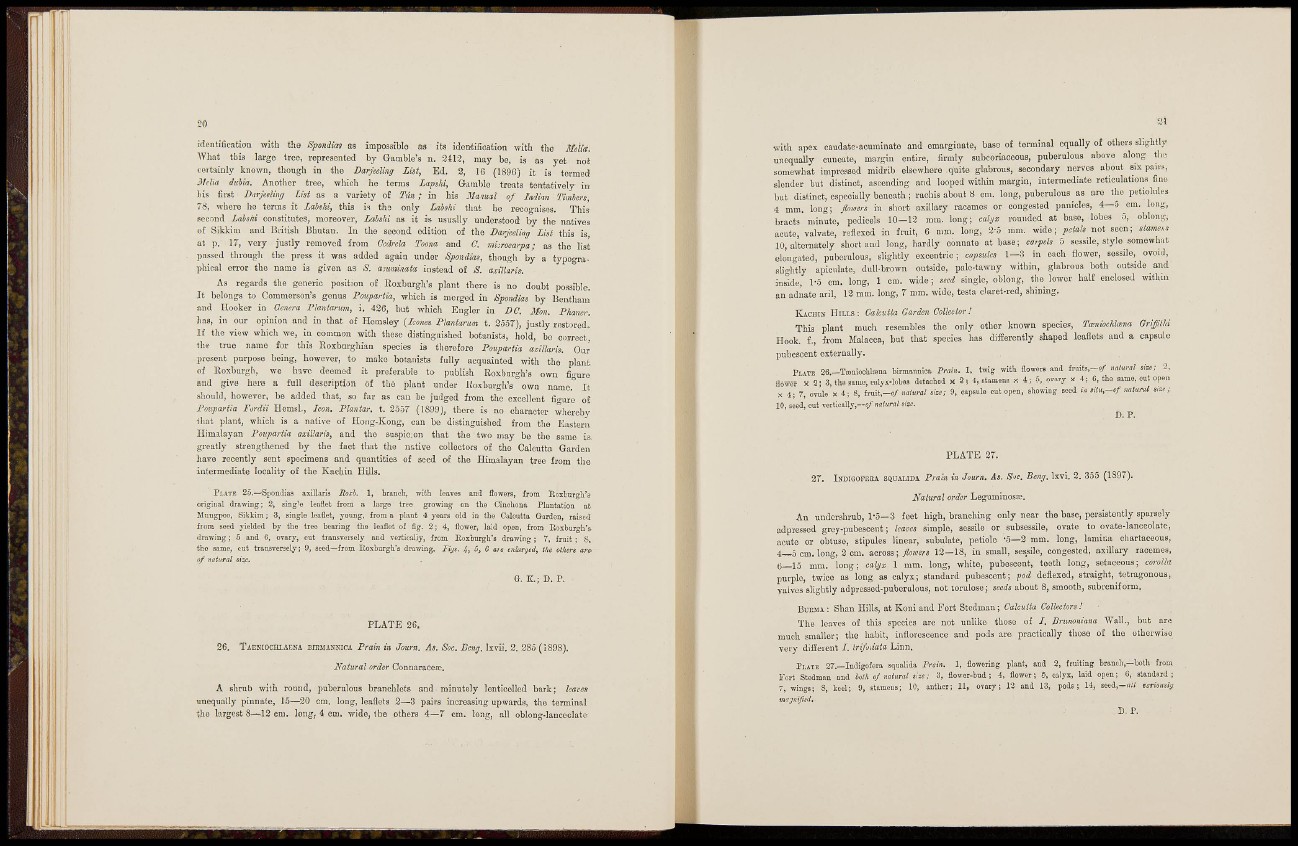
idontification -with the Spondias as impossible as its identiScation M'itli the Melia.
What tbis large tree, represented by Gamble's n. 2 i l 2 , may be, is as yet not
certainly known, though in the Darjecling Lisiy Ed, 2, 16 (1896) it is termed
3teUa duhia. Another tree, which he terms Lapshi, Gamble treats terttatively in
his first Durjeeling List as a variety of Tun; in his 31anual of Indian Timlcrs
78, where he terms it LahM, this is the only Lahshi tJiat ho recogaises. This
second Lahshi constitutes, moreover, Lahhi as it is usually understood by the natives
of Sikkiui and Edtish Bhutan. In the second edition of the Darjeeling List this is
at p. IT, very justly removed from Ccdrcla Toona and C. mi:rocarpa; as the list
passed through the press it was added again under Spondias, though by a typograjjliical
error the name is given as S. anminata instead of S. axUUris.
As regards the generic position of Eoxbiirgh's plant there is no doubt possible.
I t belongs to Commerson's genus Poupartia, which is merged in Spondias by Benthaiii
and Hooker in Genera Plantaricm, i. 42C, but which Engler in DC. 3fon. Phaner.
has, in our opinion and in that of Hemsley {Icones Plantarim t. 2557), justly restored.
I f the view which we, in common with these distinguished botanists, hold, be correct,
the true name for this Roxburghian species is tlierofore Poupctrtia avillan». Oar
present purpose being, however, to make botatiists fuUy acquainted with the plant
of Eoxburgfi, wo hare deemed it preferable to publish Roxburgh's own figure
and give here a full description of the plant under Rosburgh's own name." It
should, however, be added that, so far as can be judged from the excellent figure o£
Poupania Fordii Hemsl,, Icon. Plantar, t. 2557 (1899), there is no character whereby
ihat plant, which is a native of Hong-Kong, can be distinguished from tlie Eastern
Himalayan Poupartio. axillaris, and the suspic;on that the two may be the same is
gi-eatly strengthened by the fact that the native Golloctors of the Calcutta Garden
have recently sent specimens and quantities of seed of the Himalayan tree from the
intermediate locality of the Kachin Hills.
PLATR 25.—Spondias axillaris Roib. 1, brancli, with leaves and flowers, from Ecxl-urgk's
origiDal drawing; 2, single leoflet from a large tree gro-wiug on the Cinchona Plantation at
Mungpoo, Sikkim; 3, single leaflet, young, from a plant 4 years old in the Calcutta Garden, raiserl
from seed yielded by the tree bearing the leaflet of fig. 2; 4, flower, laid open, from liosbur^h's
drawing; 5 and 6, ovary, cut transverEely and vertically, from Eosburgh's drawing; 7, fruit; 8,
the same, cut transversely; 9, seed—froqi Hosburgh's drawing, Fiys. h, 5, G aio enlaryed, the othen are:
of natural stae.
G. K ; D. P.
P L A T E 26.
26. TAEKIOCEIAENA BMIANIACA Pram in Journ. As. Soc. Bcng. Ixvii. 2. 285 (1898).
Natural order Connaracefc.
A shrub with round, puberulous branchlets and-minutely lenticelled bark; haves
•unequally pinnate, 15—20 cm. long, leaflets 2—3 pairs increasing upwards, the terminili
the largest 8—^12 cm. long, 4 cm. wide, the others 4—7 cm. long, all oblong-lanccclate
with apex caudatc-acuminato and emargiuate, baso of terminal equally of others slightly
unequally cuneate, margin entire, firmly subcoriaceous, puberulous above along tlm
somewhat impressed midi'ib elsewhere quite glabrous, secondary nerves about six pairs',
slender but distinct, ascending and looped within margin, intermediate reticulation.s fine
but distinct, especially beneath ; rachis about 8 cm. long, puberulous as are the petiolules
4 mm. long; floiaers in short axillary racemes or congested panicles, 4—5 cm. long,
bracts' minute, pcdicels 1 0 - 1 2 mm. long; cali/x a-ouiided at base, lobes 5, oblong,
acute, valvate, reflexed in fruit, 6 mm. long, 3-5 mm. wide; petals not seen; darner..^
10, alternately .short and long, hardly connate at base; carpels 5 sessile, style somewhat
elongated, puberulous, slightly excentric; capsules 1—3 in each flower, sessile, ovoid,
shghtly apiculate, dull-brown outside, pale-tawny within, glabrous both outside and
inside, 1-5 cm. long, 1 cm. wide; seed single, oblong, the lower half enclosed within
an adnate aril, 12 mm. long, 7 mm. wide, testa claret-red, shining.
KACOIN HILLS: Calcutta Garden Collector!
This plant much resembles the only other known species, TanioeUcena GrifftlU
Hook, f., from Malacca, but that species has difíerently shaped leaflets and a capsule
pubescent externally.
PLATE 26.-TOTniocbl£ena birmannica Prnin. 1, twig with flowers and fridts,--o/ natural sise; 2.
flower X 2; 3, the same, calyx-lobes detached x 2 ; 4, stamens x 4; 5, ovary x 4; G, the same, cut open
X 4; 7, ovule x 4; 8, fruit,—o/ naittral size; 9, capsule cut open, showing seed Ú, sUit,-of naUird sc« ;
10, seed, cut vortically,—o/ natural si^a.
D. P.
27. iNDtGOFEEA SQUALTDi Prain in Journ. As. S'>c. Beng. Ixvi. 2. 355 (1897).
Natural order Leguminosce.
An undershrub, 1 - 0 - 3 feet high, branching only near the base, persistently sparsely
adpressed grey-pubescent; leaves simple, sessile or subsessile, ovate to ovate-lanceolate,
acute or obtuse, stipules linear, subulate, petiole - 5 - 2 mm. long, lamina chartaceous,
4—5 cm. long, 2 cm. across; jlotvcrs 12—18, in small, sessile, congested, axillary racemes,
(j—15 mm. long; calyx 1 mm. long, white, pubescent, teeth long, setaceous; corolla
pm-ple, twice as long as calyx; standard pubescent; ^od deflexed, straight, tetragonous,
valves slightly adpressed-puberulous, not torulose; seirf« about 8, smooth, subreniform.
BURMA : Shan Hills, at Koni and Fort Stedman; Calcutta Collectors!
The leaves of this spccies arc not unlike those of I. Brunoniana Wall., but are
much smaller; the habit, inflorescence and pods are practically those of the otherwise
very difi'eient I. irifodaia Linn.
Pi.ATB 27.—Indigofera squalida Train. 1, flowering plant, and 2, fruiting branch,—both from
i ort Stedman and holh of natural gize; 3, flower-bud; 4, flower; calyx, laid open; C, standard ;
7, wings; S, keel; 9, stamens; 10, antber; 11, OTary; 12 and 13, pods; L4, seed,-«// varioiiHn
mo J nifed.
L . r.